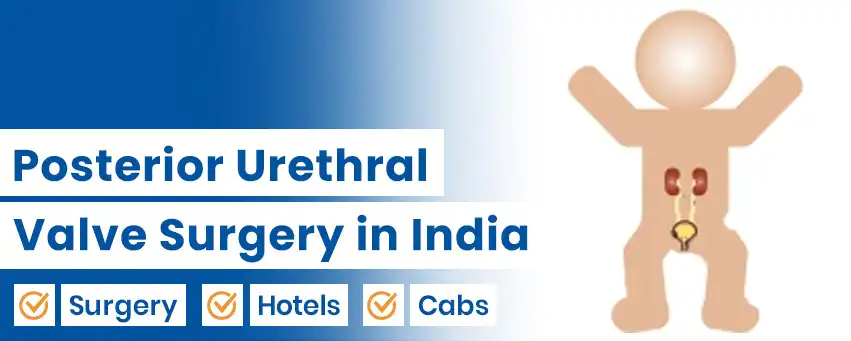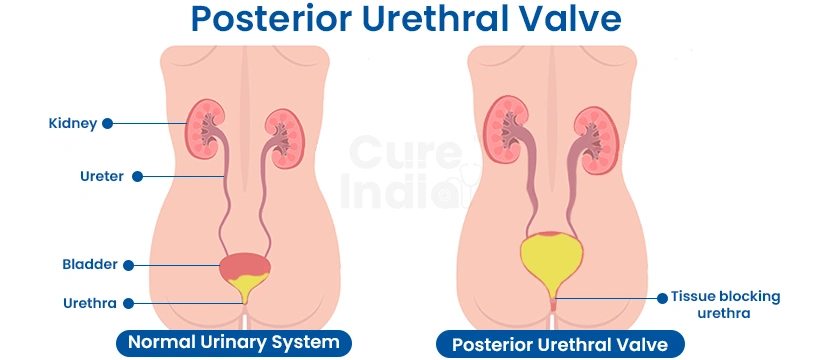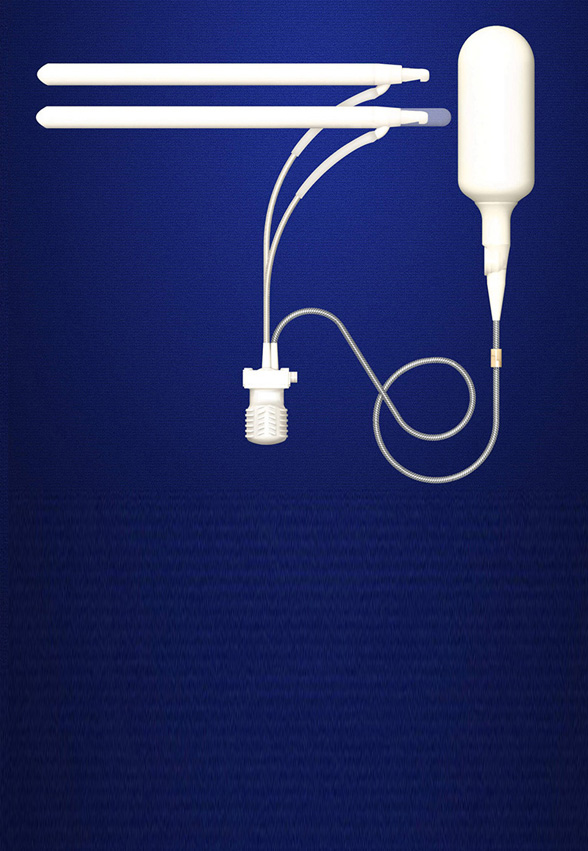

Posterior urethral valve or PUV is a rare congenital condition that affects a child from birth. Though the primary cause of this condition is still not known, it is curable with proper treatment. Also, PUV is a rare congenital anomaly that only affects babies who are assigned male at birth. In this condition, the child is born with a flap (extra) of tissue in his urethral valve or tube. This obstructs the urinary tract and prevents urine from passing through the bladder and out of the body.
This condition leads to trapping urine or pee inside the body. As a result, the traps damage urinary organ cells and swollen urinary tract and bladder. However, timely surgical intervention can help prevent fatal circumstances. It would let the affected live a normal life again. This article will be your guide to everything about PUV surgery in India, including its causes, symptoms, diagnosis, and treatment options.
Before discussing PUV causes, symptoms, or treatments, let's begin with the basics. Let's talk about what is post urethral valve. It will help you understand the condition better. PUV is a rare congenital disability that only occurs in babies assigned to males at birth. PUV or posterior urethral valves are obstructive membranes (a fold of tissue) that develop in the urethral. Urethral is a tube or valve that passes urine from the bladder and out of the body. The valve can block or obstruct urine's outflow.

Due to this obstruction, urine traps inside the body. This leads all related organs, such as the kidney, ureters, and bladder dilated/damaged.
Diagnosing the PUV requires a series of tests to determine whether it is PUV or something else. Your child's physician may begin with identifying the posterior urethral valve types. It is what your child has. Understanding its current condition helps to find a suitable treatment plan. Here are some common tests used for diagnosis of posterior urethral valves in children and newborns:
In this test, a catheter is inserted in the bladder. It is to fill it with a fluid named contrast. And when the liquid is filled an X-ray machine takes pictures of the bladder. Later, the physician examined the pictures to find the obstruction in the urinary tract.
Rental ultrasound is helpful to identify any blockage in the kidney and urinary tract.
Another popular method of posterior urethral valve diagnosis. Here a flexible rubber tube with a micro camera lens and flashlight is inserted in the urethral. The flashlight here is at the end of the tube. This is inserted to take pictures of the urinary tract.
Doctors can also suggest blood tests along with other tests to check the condition of the child's kidney.
Posterior urethral valve is a rare disorder. This disorder usually occurs during the early stages of pregnancy. At this stage, various organs of the fetus begin to form. The causes of this congenital disorder are still unknown. Some doctors suggest that this disorder can be genetically passed from one generation to another. In such cases, the father and the son suffer from this disorder. However, the majority of medical doctors and researchers rule out the assumption. They don't believe that PUV is genealogical. A baby does not inherit this disorder from their mother or father. It is also not caused by what the mother eats or does during the pregnancy.
The posterior urethral valve symptoms do not surface immediately in mild cases. In mild cases of PUV, the symptoms begin to appear near or after the age of 10 years. It is when severe dilation of the kidney or hydronephrosis has occurred. Also, with time, the symptoms get worse and even lead to kidney failure or bladder infection. Also, remember that the symptoms of mild PUV can vary from one child to another. It depends on their body and condition.
For instance, some kids may face painful urination or an enlarged bladder in the posterior urethral valve. In others, these symptoms may be absent.
Here are some common posterior urethral valve symptoms:
On the other hand, symptoms of PUV change in severe cases that often appear as a medical complication. Here are some common symptoms of severe PUV:

Posterior urethral valve surgery and treatment depends on several factors. Some of these factors are:
Depending on these factors, your child's healthcare provider creates a suitable treatment plan for your child. Here are some common surgical interventions used to treat posterior urethral valve:
Posterior urethral valves need to be removed once identified. It is done to restore the bladder and kidney function. In valve ablation, the urologist will insert a cystoscope and a microincision tool. A cystoscope is a flexible tube that has a tiny camera lens and light attached at the end. Then, the doctor uses the cystoscope to look inside. The doctor uses the incision tool to make an incision in the valve. Then it is left to fall off.
Your child's urologist may suggest a vesicostomy if your child is a newborn. It is also recommended if a condition is complicated. This condition might require a significant amount of incision. In vesicostomy, an opening in the bladder is added to ensure smooth urine drainage. Here, the urologist made a slit on the bladder wall. Then, they turn the bladder wall inside out and stitch it to the upper abdomen. Remember this procedure is a temporary solution only. In the future, the slit can be sewn together after successful valve ablation.
This procedure is less common. It is usually not suggested by doctors because of related complications. Ureterostomy involves disconnecting the ureter from the bladder. Then it is reconnected with the organ to an opening in the belly. This procedure aims to lower the chances of urinary tract infection by taking the pressure of the kidneys.
The doctor may suggest surgery if your child has been diagnosed with a posterior urethral valve. Then you should prepare your baby and yourself for the upcoming surgery. Prepare yourself mentally, physically, and emotionally to support your child. Talk to the doctor about the procedure. How long it will take, how you should prepare your baby, and what to expect after the surgery. It will help you have a clear idea and prepare for the surgery.
Treating Posterior Urethral Valve requires careful diagnosis and expert surgical intervention by a pediatric urologist or specialist trained in reconstructive urinary tract surgery. In India, ourhospitals and specialists have established a track record in managing PUV through modern surgical techniques, long‑term follow‑up, and comprehensive pediatric care. Here are some of our leading PUV treatment doctors in India:
Dr. Pankaj Wadhwa is a senior urologist affiliated with Max Super Speciality Hospital in Noida. He is an experienced PUV treatment doctor in India, holding an MBBS, an MS in General Surgery, and an MCh in urology, and he is further trained in endourology, uro‑oncology, and reconstructive and robotic urology. With around 28 years of experience, he has to date performed hundreds of advanced endoscopic and laparoscopic surgeries.

Dr. Sujit Chowdhary has over 25 years of experience in pediatric urology and pediatric surgery, making him a leading PUV surgery expert in India. He currently works as a senior consultant in pediatric urology at Apollo Hospitals, handling congenital and developmental urinary tract issues in newborns and children, including conditions such as urinary tract obstruction, posterior urethral valve, vesicoureteral reflux, hydronephrosis, and related anomalies.

Dr. Shandip Kumar Sinha is a top-rated posterior urethral valve surgeon in India who specialises in minimally invasive pediatric surgery, pediatric endourology, and reconstructive pediatric urology. He currently serves as the Director of pediatric surgery & pediatric urology at Medanta Hospital, with extensive experience of o0ver 45 years in pediatric surgical urological conditions, including congenital anomalies, neonatal surgery, and reconstructive interventions.

With over 40 years of experience, Dr. Anurag Krishna is an expert doctor for PUV treatment in India. He is currently the chairman of pediatric urology at Max Super Speciality Hospital Saket and his areas of specialisation include pediatric urology, laparoscopic and neonatal surgeries, and treatments for congenital urological and general pediatric surgical conditions.

Babies with low PUV can receive treatment after posterior urethral valve diagnosis. They will recover with time. They might not need lifelong follow-ups. Babies with moderate to severe PUV might need lifelong follow-ups after their primary treatment is done. Some children can also need lifelong care. Boys with PUV can also develop CKD (chronic kidney disease) during the later stages of their lives. This can also result in kidney failure. Expert multidisciplinary care can help boys with PUV lead normal lives. This ensures proper development of the bladder and kidney.
Doctors usually suggest PUV surgery for newborns. Instead, other measures are taken into account to deal with this health crisis. A doctor primarily aims to drain out the urine from a newborn's bladder to offload the kidneys. A tube or catheter is used for this purpose. A PUV surgery is only performed when a newborn grows up a bit. A pediatric urologist performs PUV resection by cystoscopy. The procedure requires a pediatric urologist to place a cystoscope through the urethra. The cystoscope helps them see inside the urethra and surgically remove the valves. In some rare cases, experts may suggest posterior urethral valve surgery for newborns. This is due to potentially life-threatening complications.


Suffering from Erectile Dysfunction
Open up and get treated
Semi Rigid and Inflatable Penile Implants
Get back the Erection
Insecure about your size
Get Penile Augmentation